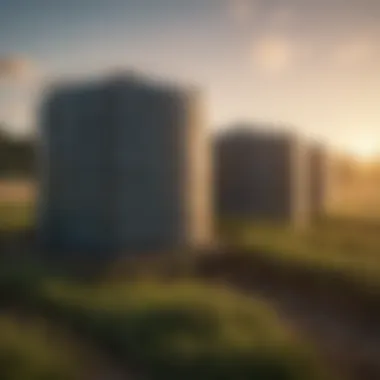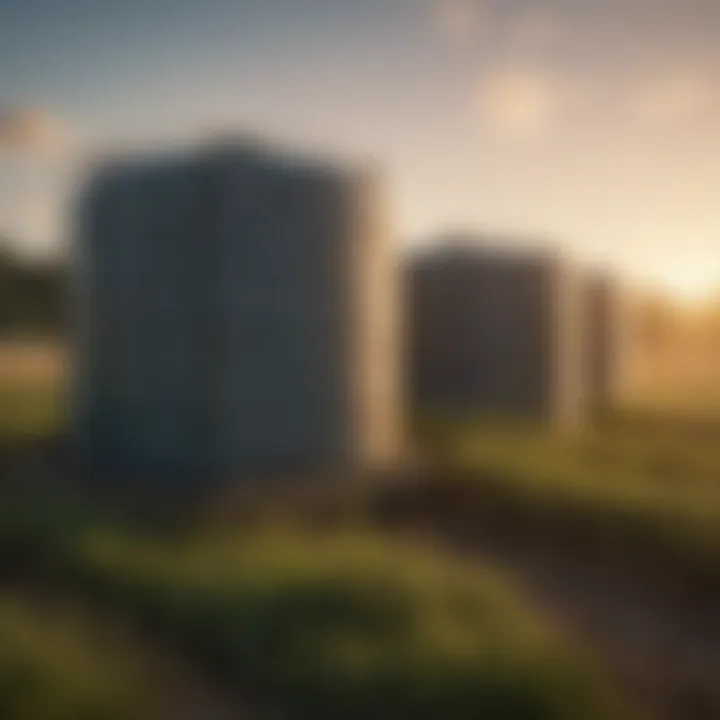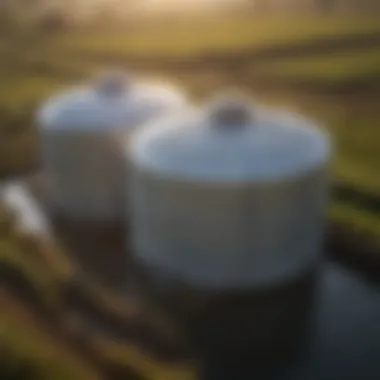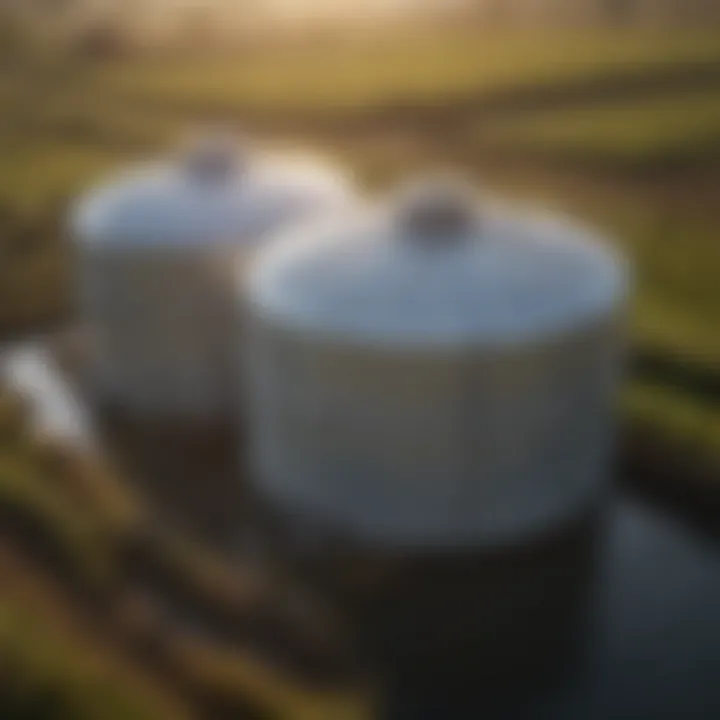The Impact of Plastic Water Tanks on Agriculture


Intro
The role of water in agriculture cannot be overstated. Farmers and horticulturalists rely on effective water management practices to grow crops and maintain their livelihood. Water tanks have emerged as essential tools in this endeavor. Among various materials available, plastic water tanks have gained prominence due to their benefits and adaptability to different agricultural contexts. This section aims to lay the groundwork for understanding the significance of plastic water tanks in agriculture and the key concepts surrounding them.
Key Concepts and Terminology
Basic Definitions
In simple terms, a water tank is a container designed to hold water. In agricultural settings, these tanks store water for irrigation, livestock consumption, and various other farming needs. Plastic water tanks are typically made from materials like polyethylene or polypropylene. These materials are durable, lightweight, and resistant to corrosion, making them suitable for outdoor applications.
Historical Context
The use of water storage in agriculture dates back centuries. Early civilizations utilized clay or stone reservoirs. With time, the introduction of metal tanks offered improved durability. However, these metal options often suffered from issues such as rusting and heavy weight. The late 20th century saw the rise of plastic water tanks, which provided an innovative solution to the drawbacks of previous materials. Since then, they have increasingly found their way into modern farming practices across the globe.
Recent Innovations and Trends
Technological Advancements
Recent developments in technology have led to the production of improved plastic water tanks. These advancements include better UV resistance, enhanced structural integrity, and the incorporation of insulation to prevent water temperature fluctuations. Some newer models now feature integrated filtration systems and sensors that monitor water levels, providing farmers with easy-to-manage solutions.
Sustainable Practices
With an increasing focus on sustainability, plastic tanks are often chosen for their environmentally friendly attributes. Many manufacturers are moving towards using recycled materials for tank production. Furthermore, the lightweight nature of plastic aids in reducing transportation emissions. By utilizing plastic tanks, farmers can adopt more sustainable practices in managing their water resources.
Practical Applications and Techniques
Steps to Selecting a Plastic Water Tank
- Assess your water needs for irrigation or livestock.
- Consider the tank's capacity, dimensions, and placement on your farm.
- Ensure compatibility with existing irrigation systems.
- Evaluate the tank's UV resistance and lifespan to minimize replacement costs.
Case Studies
- A small-scale organic farm in California integrated a multi-functional plastic water tank, not just for irrigation but also for rainwater harvesting. This approach led to decreased water costs and improved crop yield.
- In Australia, a cattle ranch adopted a series of plastic tanks to supply drinking water to livestock situated in remote areas. This system improved herd health, minimizing waterborne diseases.
"Sustainable water management is crucial for the future of agriculture. Choosing the right materials and systems influences crop productivity significantly."
Preface to Agricultural Water Tanks
Agricultural water tanks are crucial in sustaining farming practices. They store water for irrigation, livestock, and other agricultural needs. Understanding their functionality and importance is essential for farmers and agricultural enthusiasts. They not only provide a resource for plants and animals but also influence crop yields and farm productivity.
The focus on plastic water tanks in agriculture is particularly relevant today. Plastic tanks offer various benefits compared to traditional materials. They present solutions for modern challenges like water scarcity and environmental concerns. Moreover, as the agricultural sector evolves, so does the technology and materials used in farming practices. Plastic water tanks exemplify this evolution, merging efficiency with adaptability.
Defining Agricultural Water Tanks
Agricultural water tanks are storage systems designed specifically to hold and manage water for various farming activities. These tanks can differ in size and shape depending on the intended use. Common forms include cylindrical and rectangular tanks, each serving specific agricultural needs. Tanks can be found above ground or below ground, with characteristics affected by factors like local climate, available space, and type of crops.
Water tanks fulfill a fundamental role in irrigation setups, ensuring a reliable supply of water to crops. Aside from storing water from wells or municipal sources, they may also collect rainwater through harvesting systems. Their primary purpose remains critical as they help mitigate the risks posed by fluctuating weather conditions.
Importance of Water in Agriculture
Water is vital in agriculture. It is essential for plant growth, acting as a medium for nutrient absorption. Agriculture consumes about 70 percent of the world's freshwater resources. Therefore, efficient water storage and management systems are key to sustaining agricultural operations.
The capability to store water effectively influences the overall productivity and success of farming enterprises. Here are a few reasons why water is crucial:
- Crop Health: Adequate water supply maintains soil moisture, which is essential for sustainable plant health.
- Yield Optimization: Proper irrigation strategies improve crop yields and quality.
- Livestock Needs: Livestock requires a consistent water supply for health and productivity, impacting overall farm profitability.
Types of Water Tanks Used in Agriculture
Water tanks play a crucial role in agriculture, facilitating efficient water management. Selecting the right type of tank impacts not only the cost but also the sustainability and effectiveness of agricultural practices. Understanding the various types of water tanks is essential for farmers and agricultural enthusiasts, as this knowledge helps in making informed decisions about water storage solutions. Each tank type is associated with its unique characteristics, advantages, and limitations. Evaluating these factors will assist in optimizing water usage, ensuring that irrigation and livestock needs are met with minimal environmental impact.
Metal Tanks
Metal tanks have been a staple in agricultural settings for a long time. Made from materials like galvanized steel or stainless steel, they offer significant durability and longevity. Their strength allows them to withstand external pressures, which can be beneficial in various weather conditions.
However, they come with both advantages and disadvantages.
- Pros:
- Cons:
- High strength and resistance to damage: Metal tanks can endure physical impacts and harsh environmental elements, making them suitable for long-term use.
- Good thermal retention: They can help maintain water temperature, important for applications like livestock watering.
- Corrosion risk: Over time, repeated exposure to moisture can lead to rust and deterioration, making ongoing maintenance a necessity.
- Higher initial costs: Metal tanks tend to be more expensive compared to alternatives like plastic, which can be a limiting factor for smaller farms.
Concrete Tanks
Concrete tanks are another popular choice for agricultural water storage. They often feature a more permanent installation, which is advantageous for long-term agricultural settings. These tanks are generally poured or pre-cast, making them strong and heavy.
Their key benefits include:
- Longevity: Concrete can last decades when installed properly, offering a long-term solution for water storage.
- Insulation properties: The material provides good insulation, which helps in keeping water temperature stable.
However, their downsides must also be acknowledged:
- Heaviness and difficulty in transport: Once installed, they cannot be easily moved. This makes them less suitable for farms that may expand or change configurations.
- Cost implications: The installation of concrete tanks can be costly due to construction and labor expenses.
Plastic Tanks


Among the various types of water tanks used in agriculture, plastic tanks have become increasingly popular due to their versatility and numerous advantages. Commonly made from polyethylene or polypropylene, these tanks epitomize modern water storage solutions.
Here are some highlights of plastic tanks:
- Lightweight and portable: Their low weight makes transportation and installation easier, allowing users to adjust their water storage as needed.
- Resistance to corrosion: Unlike metal tanks, plastic tanks do not corrode, which can lead to lower maintenance costs.
Plastic tanks also provide flexibility in design, making them suitable for a wide range of agricultural applications. They can be utilized in irrigation, livestock watering systems, and even for rainwater harvesting.
However, not all is without challenges:
- Susceptibility to damage: While they resist corrosion, plastic tanks can be vulnerable to punctures and UV degradation without proper care.
- Environmental concerns: The use of plastics raises questions about sustainability and recyclability, which are valid considerations for environmentally conscious farmers.
Overall, choosing the right water tank is a crucial decision influenced by several factors including budget, ease of use, and specific agricultural needs. Understanding the attributes of each option will ultimately lead to better water management and contribute to successful agricultural practices.
Advantages of Plastic Water Tanks
Plastic water tanks have steadily gained recognition in the agricultural sector due to their numerous advantages. Understanding these benefits is crucial for farmers and agricultural enthusiasts who seek efficient and effective water storage solutions. The advantages of plastic water tanks contribute significantly to improved agricultural practices and resource management.
Lightweight and Portable
One of the most notable advantages of plastic water tanks is their lightweight nature. Unlike metal or concrete tanks, plastic tanks are easy to handle and transport. This makes installation and relocation simpler, which is an essential consideration for farmers who may need to adjust their water storage solutions as their operations evolve.
- Ease of Transport: The reduced weight allows for lower labor costs during setup. Farmers can save time and effort when moving tanks around their farms.
- Accessibility: With lower weight, these tanks can be placed in diverse locations, optimizing water access for various crops and livestock.
The portability of plastic tanks supports flexible agricultural practices. Farmers can adjust to changing water needs without heavy machinery or overly complicated logistics.
Cost-Effectiveness
When considering the investment in water storage solutions, cost-effectiveness becomes a primary concern. Plastic water tanks often come at a lower initial price compared to their metal and concrete counterparts. This lower cost is a significant benefit for small and medium-sized farms looking to optimize their budgets.
- Lower Upfront Costs: The affordability of plastic tanks allows for immediate implementation. Farmers can allocate finances to other critical areas of their operations.
- Reduced Maintenance Expenses: Plastic tanks typically require less maintenance than metal tanks, which can corrode over time. This reduction in long-term upkeep costs provides additional savings.
In essence, the economic advantages linked to plastic tanks can enhance overall farm profitability, making them an appealing option for those in agriculture.
Resistance to Corrosion
Plastic water tanks exhibit remarkable resistance to corrosion, setting them apart from metal options. Corrosion can significantly compromise tank integrity, leading to leaks and water contamination.
- Longevity: The material used in plastic tanks is designed to withstand harsh environmental conditions, extending the lifespan of the tanks and ensuring reliable water storage.
- Safety: The non-corrosive nature of plastic prevents harmful substances from leaching into the water supply, safeguarding the health of crops and livestock.
Farmers can have peace of mind knowing that their water storage systems are resilient and do not contribute to environmental concerns related to contamination.
"Choosing the right water tank is not just about storage; it’s about ensuring health and efficiency in agricultural practices."
In summary, the advantages of plastic water tanks are undeniable. Their lightweight and portable nature eases logistics, while cost-effectiveness plays a significant role in promoting economic viability. Moreover, their resistance to corrosion ensures that water stays clean and safe for agricultural use, reinforcing their value in modern farming.
Potential Disadvantages of Plastic Tanks
While plastic water tanks offer numerous advantages in agricultural settings, they are not without their drawbacks. Understanding these potential disadvantages is crucial for farmers and agricultural professionals who seek effective and sustainable water storage solutions. This section delves into key aspects, including susceptibility to damage, environmental concerns, and limited lifespan. By acknowledging these downsides, stakeholders can make informed decisions about the use of plastic tanks in their operations.
Susceptibility to Damage
Plastic water tanks can be more vulnerable to physical damage compared to metal or concrete tanks. They may easily crack or dent, particularly when exposed to extreme weather conditions such as hail or heavy winds. Additionally, the impact from farming equipment can lead to noticeable wear and tear over time. This susceptibility may require regular inspections to identify any damage early on, preventing potential leaks or failures in water storage. The flexibility of plastic, while generally an advantage, can make tanks prone to deformation under intense pressure, especially when filled to capacity.
Environmental Concerns
The use of plastic in agriculture raises significant environmental issues. Firstly, plastics are derived from petroleum, which contributes to fossil fuel depletion. The production process of plastic water tanks also often involves substantial carbon emissions. Once their lifespan is over, improper disposal of plastic tanks can lead to long-term environmental pollution, as many plastics are not biodegradable. While some recycling programs exist, not all regions have the infrastructure in place to recycle these materials effectively. It is vital for users to consider sustainable practices, such as proper recycling or choosing manufacturers that employ eco-friendly materials in their production processes.
Limited Lifespan
Compared to metal or concrete alternatives, plastic tanks typically offer a shorter lifespan. Although they are resistant to rust and corrosion, factors such as UV exposure can significantly degrade standard plastic materials over time. Exposure to sunlight can lead to brittleness and eventual failure of the tank. Farmers should expect to replace plastic tanks more frequently, which can increase overall operational costs. Regular maintenance can help extend the functional life of these tanks, but budgeting for replacement is a crucial consideration when opting for plastic.
"Balancing the pros and cons of plastic tanks is essential for sustainable agricultural practices."
Manufacturing Processes of Plastic Water Tanks
The manufacturing processes of plastic water tanks are essential to understanding their functionality and reliability in agricultural settings. The choices made in this phase significantly impact the tanks' durability, ease of use, and overall effectiveness in serving agricultural needs. As it stands, the agricultural sector seeks solutions that align with sustainability and efficiency. Therefore, comprehending the intricacies of how these tanks are produced is of great importance.
Materials Used in Production
The materials selected for producing plastic water tanks play a crucial role in determining their quality and lifespan. The most commonly used material is high-density polyethylene (HDPE). This material is favored for its strength, flexibility, and resistance to impact. Its UV protection properties also make it suitable for outdoor use, ensuring that the tank can withstand harsh weather conditions.
Another material often considered is polypropylene. While it is not as widely used as HDPE, it offers good chemical resistance and durability as well. Knowing the characteristics and benefits of these materials helps in choosing the right tank for specific agricultural applications.
Some other materials may include:
- PVC: Lightweight and easier to mold but less durable than HDPE.
- Recycled Plastics: Environmentally friendly option, though quality can vary.
Step-by-Step Manufacturing Process
The manufacturing process of plastic water tanks involves several steps, from raw material selection to the final product. Below is a simplified view of the process:
- Material Preparation: Raw plastic granules are prepared and blended with additives. These might include UV stabilizers and colorants.
- Melting: The material is heated in an extruder until it becomes molten. This ensures that the plastic can be molded into the desired shape.
- Molding: The molten plastic is injected or blown into molds. This step largely determines the tank's shape and size.
- Cooling: Once the tank takes shape, it is cooled. This step solidifies the structure, ensuring it retains the desired form.
- Finishing Touches: After cooling, additional processes such as trimming and inspection are conducted. Quality assurance is critical to identify any defects before the tank reaches the market.
Each of these steps influences the final product's quality. A well-constructed tank can provide reliable water storage, while a poorly made one might fail under pressure or during adverse conditions.
"The manufacturing quality of plastic water tanks can directly affect the agricultural outcomes they support. Understanding this process is vital for choosing the right tank."


By exploring these manufacturing processes, farmers and agricultural enthusiasts can make informed decisions that meet their specific water storage needs.
Applications of Plastic Water Tanks in Agriculture
Plastic water tanks serve vital roles in agricultural settings, underlining their significance in optimizing water usage and management. With increasing demand for sustainable practices, the applications of plastic water tanks in agriculture reflect a trend toward efficiency and versatility. These tanks fulfill diverse needs, from irrigation to livestock hydration, and rainwater collection, enhancing agricultural productivity while minimizing resource waste.
Irrigation Systems
Irrigation is fundamental to successful agriculture. Plastic water tanks can efficiently store water sourced from wells, rivers, or rain. These tanks are often strategically located to serve irrigation systems, ensuring easy access to water when needed. The lightweight nature of plastic tanks allows for easier handling and installation, which is essential for remote farming areas.
Moreover, the tanks can be linked to drip irrigation systems, providing a steady water supply directly to crops. This method significantly reduces evaporation losses, promoting optimal soil moisture levels. Effective irrigation helps in increasing crop yields and ensures that the water is used judiciously.
Livestock Watering Solutions
Access to fresh water is essential for livestock health. Plastic water tanks serve as a reliable water source for various types of animals including cattle, sheep, and poultry. Their design can be adapted to provide easy drinking access without compromising hygiene.
The tanks can maintain water temperature and quality, essential during extreme weather conditions. For instance, in hot climates, black plastic tanks can help keep the water warmer by absorbing heat. Regular water availability in tanks also encourages livestock to drink more, which leads to better growth rates and overall health.
Rainwater Harvesting
Rainwater harvesting is a sustainable approach gaining favor in agricultural practices. Plastic water tanks are adept at collecting and storing rainwater that can later be used for irrigation, livestock, or even household needs. This not only conserves resources but also reduces dependency on mains water supply.
Using plastic tanks for rainwater harvesting can significantly lower water bills and promote eco-friendly practices. Farmers can easily set up systems to direct rainwater from rooftops or other surfaces into the tanks, thus maximizing water utility during dry spells.
Ultimately, the diverse applications of plastic water tanks in agriculture underline their essential role. They promote sustainable practices, ensure efficient water management, and contribute toward robust agricultural productivity.
Maintenance of Plastic Agricultural Water Tanks
Proper maintenance of plastic agricultural water tanks is crucial for ensuring their longevity and functionality. Regular care can prevent common issues such as leaks and structural damage, enhancing their reliability in agricultural applications. Maintaining these tanks also plays a vital role in safeguarding water quality, which is essential for crops and livestock. Any lapse in maintenance could lead to more significant problems, result in costly repairs, or pose risks to health and safety.
Regular Inspection Protocols
Regular inspections are essential for identifying potential issues before they escalate. Farmers should establish a schedule for visual inspections, ideally checking the tanks at least once a month. During these assessments, several key factors should be evaluated:
- Structural Integrity: Look for cracks or signs of wear on the tank's surface.
- Water Quality: Check for discoloration or unusual odors indicating contamination.
- Fittings and Outlets: Ensure that all connections are secure and free from leaks.
- Environmental Factors: Assess if nearby vegetation or weather conditions could affect the tank's condition.
Maintaining a detailed record of these inspections can be helpful in tracking changes and scheduling further assessments.
Cleaning and Sanitization Guidelines
To maintain water quality, cleaning and sanitization should be performed at least twice a year, or more frequently if the tank is exposed to high levels of contamination. Here are some steps to follow:
- Drain the Tank: Completely empty the tank before starting the cleaning process.
- Scrubbing: Use a soft brush and a soap solution to scrub the interior walls thoroughly.
- Sanitizer Application: After cleaning, apply a food-grade sanitizer to disinfect the surfaces.
- Rinse: After sanitizing, rinse the tank with clean water to remove any residual cleaning agents.
- Fill with Water: Refill the tank with clean water, ensuring it meets agricultural standards.
Regular cleaning helps prevent algae build-up, which can negatively impact water quality.
Repair Techniques
In the event of damage or wear, timely repairs are essential to prolong the life of a plastic tank. Here are some effective repair techniques:
- Patch Repairs: For small cracks or holes, specialized plastic adhesives or patch kits can provide quick fixes.
- Reinforcement: If a crack is large, reinforcing the area with additional plastic sheeting can serve as a temporary solution.
- Replacement of Parts: Sometimes specific components like valves or fittings may need replacement. Keeping spare parts on hand can expedite repairs.
- Consult Professionals: For extensive damage, it’s often best to consult professionals who specialize in tank repair or replacement.
Addressing repairs promptly will ensure that plastic water tanks continue to function effectively in agricultural applications, supporting their vital role in modern farming practices.
Effective maintenance not only extends the life of plastic agricultural water tanks but also plays a crucial role in ensuring the quality of water used for farming.
Sustainability and Environmental Impact
Sustainability in agriculture is a crucial topic as it relates directly to efficient resource use and environmental stewardship. The adoption of plastic water tanks plays a significant role in enhancing sustainable practices within farming. They serve not only to store water but also address broader environmental concerns.
Recyclability of Plastic Tanks
One of the primary environmental benefits of plastic water tanks is their recyclability. Modern plastic materials, such as polyethylene, are often recyclable, which reduces waste. When farmers reach the end of a tank's useful life, proper recycling channels can reclaim the material.
- Reduction of Landfill Waste: Recycling diverts plastic from landfills, reducing the environmental footprint.
- Resource Reuse: Recycled plastic can be used in new products, conserving raw materials.
- Encouragement of Recycling Programs: Farmers can be encouraged to participate in recycling initiatives, fostering a culture of sustainability.
Energy Consumption During Production
While the benefits of using plastic tanks in agriculture are apparent, it's vital to consider the energy consumption involved in their production. The manufacturing process for plastic tanks requires energy, which can contribute to greenhouse gas emissions.
Factors affecting energy usage include:
- Raw Material Extraction: The extraction of petroleum-based plastics demands significant energy.
- Production Processes: The process of molding and shaping plastic into tanks is energy-intensive.
- Transport: Moving finished tanks to farms uses additional energy, impacting the overall sustainability profile.
"Understanding the energy costs of producing plastic tanks helps in assessing their impact on sustainability in agriculture."
Regulatory Considerations and Standards
Understanding regulatory considerations and standards regarding agricultural water tanks is essential for ensuring safety and efficiency in their use. Regulations play a crucial role in protecting not only the end-users but also the environment. Compliance with industry standards leads to better quality products, which are vital for the sustainability of farming practices.
Regulatory frameworks govern various aspects, such as materials used, storage capacities, and construction methods of water tanks. These regulations help in minimizing health risks associated with contaminated water storage. Furthermore, industries benefit from standards as they offer guidelines that can enhance the design of water tanks, preventing issues that could arise from poor materials or construction practices.
Key benefits of adhering to regulations include:
- Safety Assurance: Regulatory compliance ensures that water tanks meet safety standards, protecting users from potentially hazardous conditions.
- Environmental Protection: Standards help mitigate negative environmental impact by encouraging the use of eco-friendly materials and sustainable practices.
- Market Accessibility: Products that meet specific regulations can be marketed with greater credibility, enhancing consumer trust.


Farmers and agricultural professionals should understand these regulations to ensure they select storage solutions that are not only effective but also compliant with legal and safety standards.
Comparative Analysis with Other Materials
The comparative analysis of agricultural water tanks is essential to understanding their characteristics and performance in various conditions. This section evaluates plastic tanks against metal and concrete alternatives, emphasizing the distinct advantages and drawbacks of each material. Understanding these differences helps farmers and agricultural professionals make informed purchasing decisions. Factors such as durability, cost, and maintenance requirements should be considered carefully.
Plastic vs. Metal Tanks
When comparing plastic tanks to metal tanks, several factors emerge as crucial. Plastic water tanks are typically lightweight, which simplifies handling and installation. This aspect often gives them an edge over metal tanks, which can be quite heavy and require more robust infrastructure for support. The cost of plastic tanks tends to be lower than their metal counterparts, making them an appealing choice for those on a budget.
Maintenance is another significant difference. Plastic tanks are resistant to rust and corrosion, while metal tanks can suffer from these problems if not properly coated or treated. This corrosion can compromise the structural integrity of metal tanks over time. Additionally, if a metal tank leaks, it often requires welding or other professional repairs, which can increase maintenance costs. In contrast, small leaks in plastic tanks can often be repaired simply and inexpensively.
However, there are considerations on the downside. Metal tanks generally offer better UV resistance and insulation capabilities than plastic tanks, making them more suited to extreme weather conditions. Their lifespan can also be longer when properly maintained.
In summary: While plastic tanks provide lightweight, cost-effective, and low-maintenance options, metal tanks offer superior durability and weather resistance that may be necessary in some farming environments.
Plastic vs. Concrete Tanks
When it comes to plastic tanks and concrete tanks, the differences are just as stark. Plastic tanks, as mentioned, are lightweight and portable. This can be particularly beneficial in areas needing frequent relocation or in installations requiring flexibility. Concrete tanks, however, provide a greater degree of stability due to their weight, making them suitable for larger scale agricultural operations where high capacity is essential.
Cost is another important factor. Concrete tanks typically involve a higher initial investment, requiring not just materials but also potentially costly labor for installation. In contrast, while plastic tanks have lower upfront costs, their lifespan can be shorter if environmental conditions are harsh.
One main benefit of concrete tanks is their superior longevity. They are generally capable of withstanding extreme weather conditions and provide excellent thermal insulation. However, transport and installation of concrete tanks are more complicated and time-consuming, as they often require specific site preparation.
In terms of maintenance, plastic tanks are often easier to handle. For instance, cleaning them is simpler, and repairs can often be done without professional help. On the other hand, concrete tanks can crack, and when they do, repairs may require significant effort and expense.
Emerging Trends in Agricultural Water Storage
The significance of emerging trends in agricultural water storage is becoming increasingly vital as the industry adapts to changing environmental conditions and growing demands. Farmers and agricultural enthusiasts are exploring new technologies and methods to optimize their water usage. This section aims to dissect the trends that are shaping the future of water storage solutions, particularly focusing on advanced methodologies and innovative designs. Understanding these trends helps stakeholders in agriculture make informed decisions regarding the sustainability and efficiency of water usage in their practices.
Smart Water Management Systems
Smart water management systems represent a significant leap forward in agricultural water usage. These systems utilize sensor technology, data analytics, and automated control to optimize irrigation and water storage by monitoring various factors. For instance, they can assess soil moisture levels, rainfall data, and crop requirements, ensuring that water is applied only when necessary. This leads to improved water efficiency and reduced wastage, which is crucial in arid regions or during drought periods.
Key benefits of smart water management include:
- Reduced Resource Waste: Precise data enables targeted watering, minimizing evaporation and runoff.
- Improved Crop Yields: Timing and amount of irrigation can be optimized for maximum growth.
- Data-Driven Decisions: Farmers can base their practices on real-time data, allowing for adaptability in unpredictable conditions.
For farmers looking to implement these systems, various platforms are available. Technologies such as wireless sensors and mobile applications provide user-friendly interfaces for monitoring and managing water resources effectively. This integration of technology not only makes water management efficient but also aligns with the broader framework of precision agriculture.
Innovative Designs and Technologies
Innovative designs in agricultural water tanks are also evolving. The introduction of modular tank systems provides flexibility that traditional single-tank solutions lack. These modular designs allow farmers to scale up their water storage capacity according to changing agricultural needs. Moreover, advancements in materials science have produced tanks that are not just lightweight, but also engineered for optimal UV resistance and durability.
Noteworthy developments include:
- Gravity-Feed Systems: Utilizing gravity to distribute water efficiently, reducing the need for electric pumps.
- Integrated Filtration Systems: Modern tanks often come with built-in filtration options, enhancing water quality directly at the source.
- Smart Sensors for Monitoring: Tanks equipped with smart sensors to detect leaks or water levels, facilitating timely maintenance.
Overall, these designs significantly address both functional and environmental considerations in agriculture. By reducing reliance on traditional materials and methods, they cater to sustainability goals while enhancing overall efficiency in water management.
"The future of agricultural water storage lies in the intelligent integration of technology and ecological sustainability."
As a result, the understanding and application of these trends in agricultural water storage are instrumental in facing present and future challenges. Embracing innovative technology in water management fosters a more sustainable approach toward agriculture, ensuring that resources are utilized effectively and responsibly.
Case Studies
Case studies play a critical role in understanding the practical implications and real-world applications of plastic water tanks in agriculture. They offer insights into how these tanks function under various conditions and provide concrete examples of their effectiveness or challenges in different scenarios. By examining specific instances, farmers and agricultural enthusiasts can learn from both successes and setbacks, informing their own water storage strategies.
Successful Implementation Examples
Successful implementation of plastic water tanks can be observed in numerous agricultural projects worldwide. One notable example is the usage of large plastic tanks in drip irrigation systems across California. These tanks are utilized to store rainwater, which is then efficiently distributed through drip lines to crops. This method not only conserves water but also reduces the dependence on underground water sources.
Similarly, in regions such as India, plastic tanks have been integrated into systems for livestock watering. Farmers have reported improvements in livestock health and productivity when using these easily maneuverable tanks that can be filled and maintained with minimal effort.
Another successful case is seen in the use of modular plastic tanks in urban farming spaces. Startups focused on sustainable agriculture have adopted these tanks for vertical farming projects. Their lightweight nature allows for easy transportation and installation, making them ideal for urban settings where space is limited.
Lessons Learned from Failures
While there are many successful case studies, it is equally important to analyze failures to avoid similar pitfalls. In some instances, plastic tanks were used in extreme weather conditions without proper anchoring or support, leading to structural damage. These cases highlight the necessity of considering environmental factors when selecting materials for water storage.
Another area of concern pertains to the improper handling of plastic tanks. Instances have occurred where tanks were not cleaned adequately, leading to contamination of stored water. This emphasizes the significance of clear maintenance protocols to ensure water quality is upheld.
Lastly, certain projects attempted to scale too quickly without adequate funding or community support. This often results in incomplete installations and underutilized resources. Understanding these lessons can help future projects avoid similar challenges by emphasizing the importance of planning and community engagement.
"Real-world applications of plastic water tanks reveal both the promise and challenges inherent in agricultural practices. Learning from the proven strategies as well as missteps can significantly enhance success rates."
Overall, case studies serve as a valuable resource for farmers, providing them with the knowledge and tools needed to make informed decisions regarding plastic water tanks. By learning from both successful implementations and failures, the agricultural community can refine its practices and achieve more effective water management solutions.
The End
Summary of Key Points
In this concluding section, we summarize the key points discussed throughout the article regarding plastic agricultural water tanks. First, plastic tanks are highlighted for their lightweight nature and ease of transportation. Their cost-effectiveness also stands out, making them a practical choice for many farmers.
Additionally, the resistance to corrosion is a critical point, especially when compared to metal alternatives. However, the disadvantages, such as susceptibility to damage and environmental concerns, cannot be overlooked. Addressing these issues is essential for sustainable use.
good maintenance practices, like regular inspection and cleaning, enhance longevity. Implementation of plastic water tanks in various settings, including irrigation systems and livestock watering, showcases their versatility. Many have adopted innovative practices, and the efficacy of these tanks in water storage continues to be evaluated.
Future Perspectives in Agricultural Water Tanks
The future of plastic agricultural water tanks looks promising. As technology evolves, new materials might emerge, offering even better durability and sustainable options. Smart water management systems will likely play a significant role in optimizing water use efficiency in agriculture. This integration could lead to more informed decision-making in water management.
Moreover, innovations in designs and manufacturing processes could address existing weaknesses in current plastic tanks, such as their limited lifespan and overall environmental impact. Advances in recycling processes and materials could transform plastic waste into valuable resources, fostering a more sustainable agricultural practice.















